
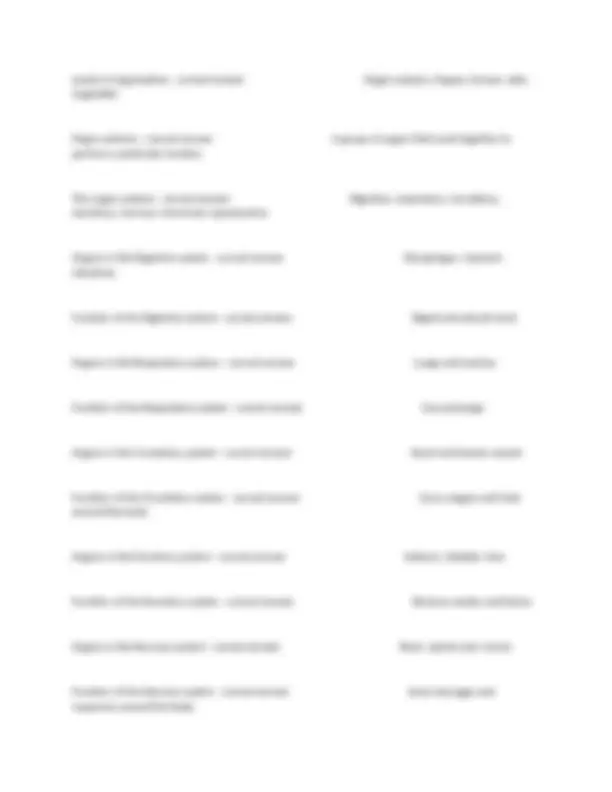
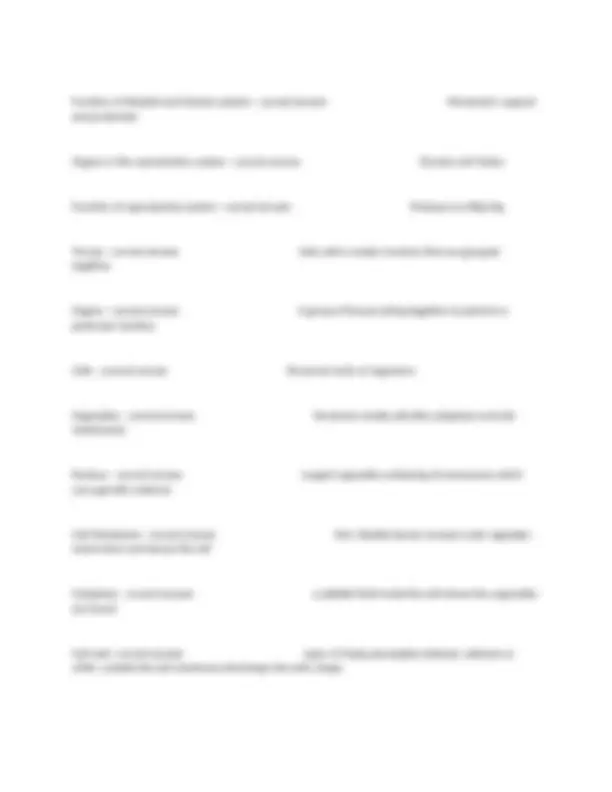
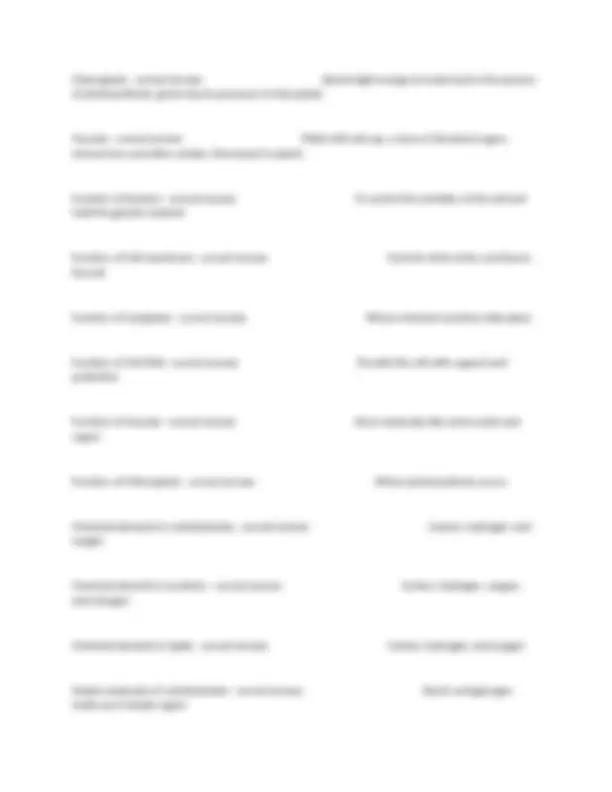
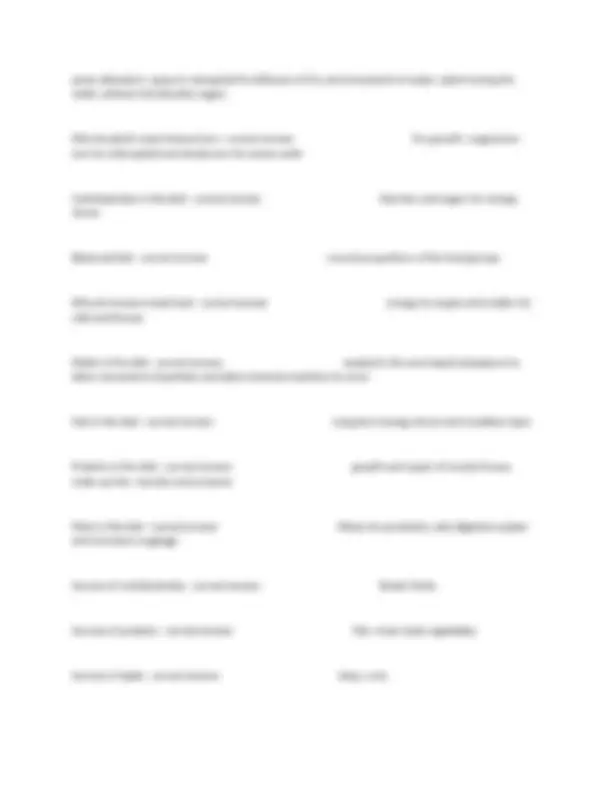
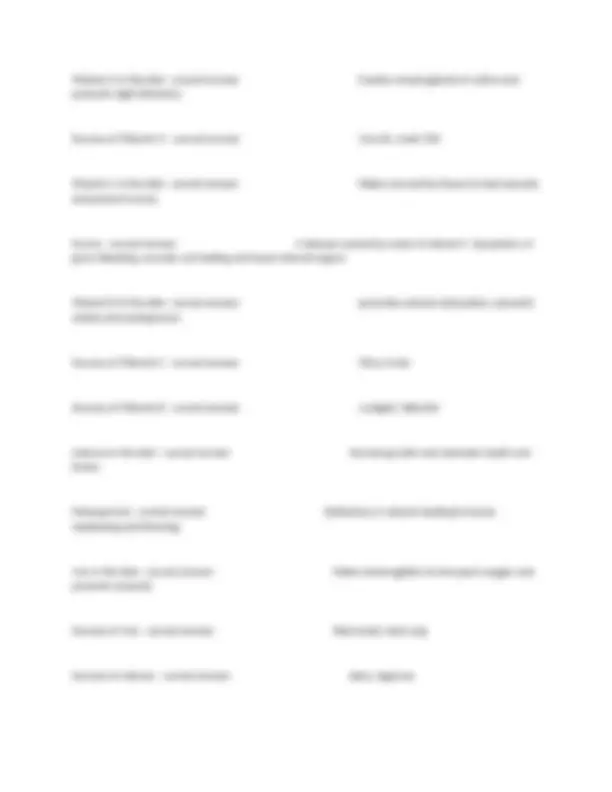
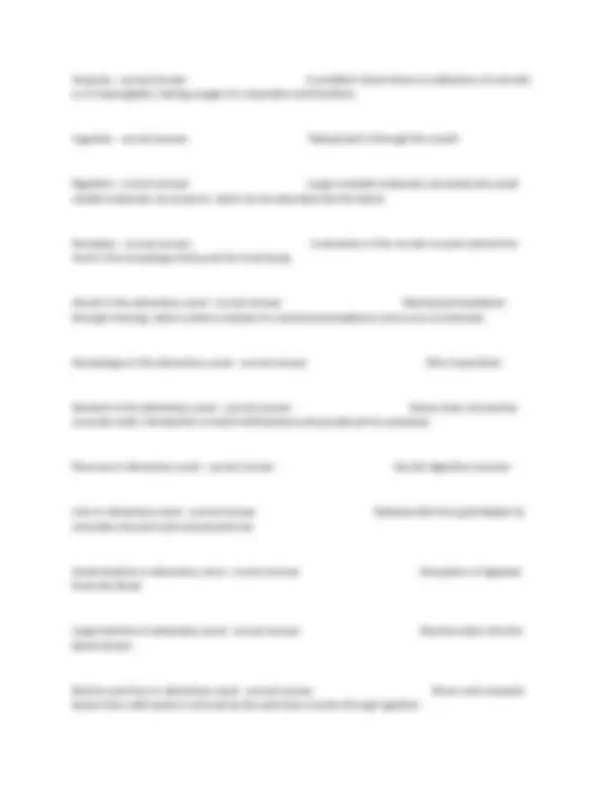
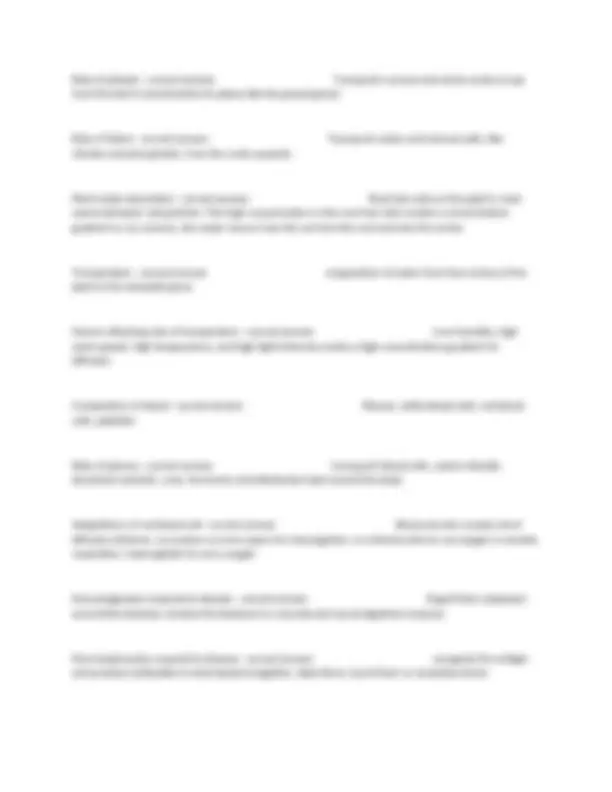
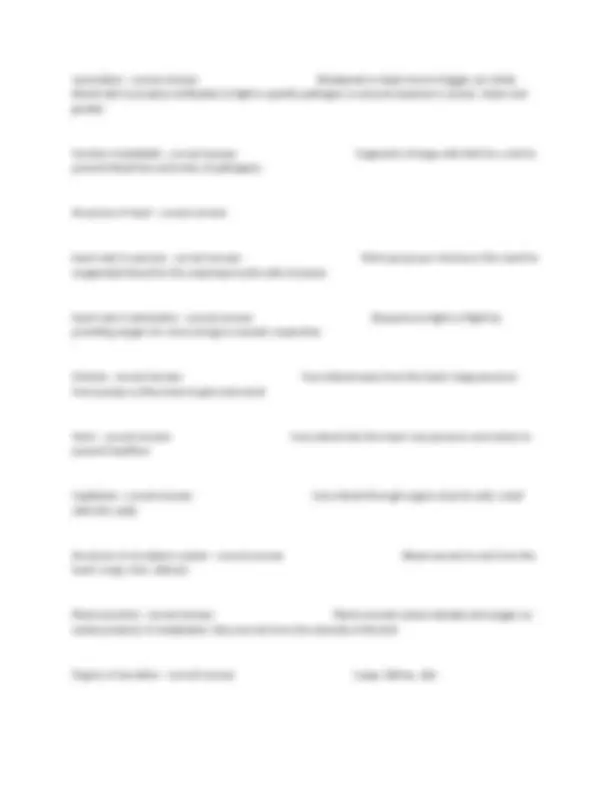
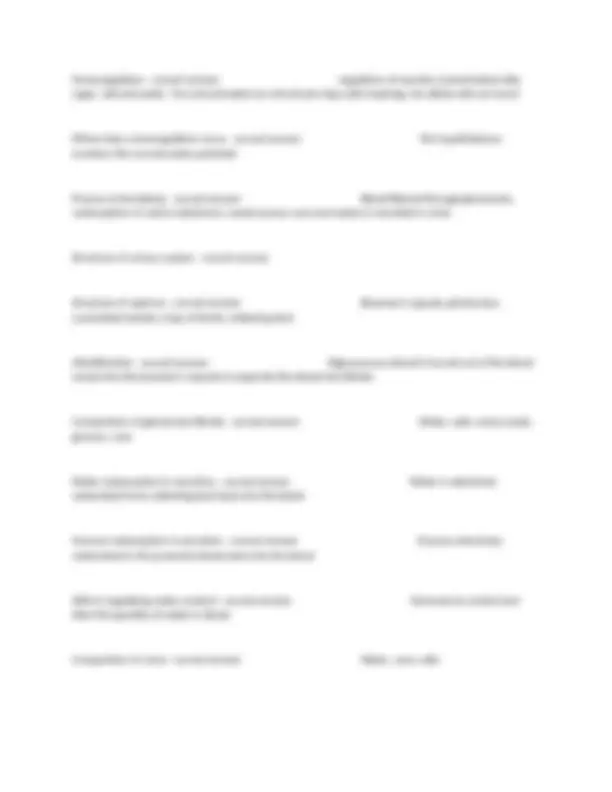
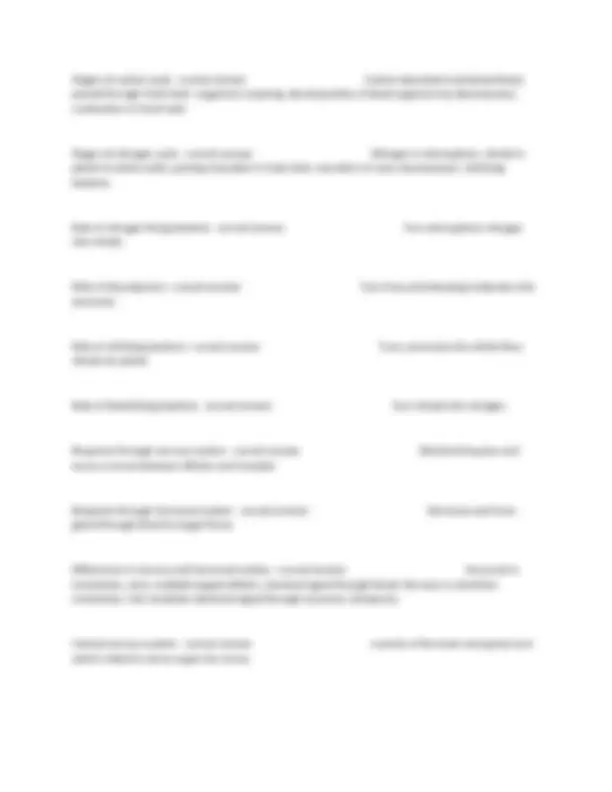
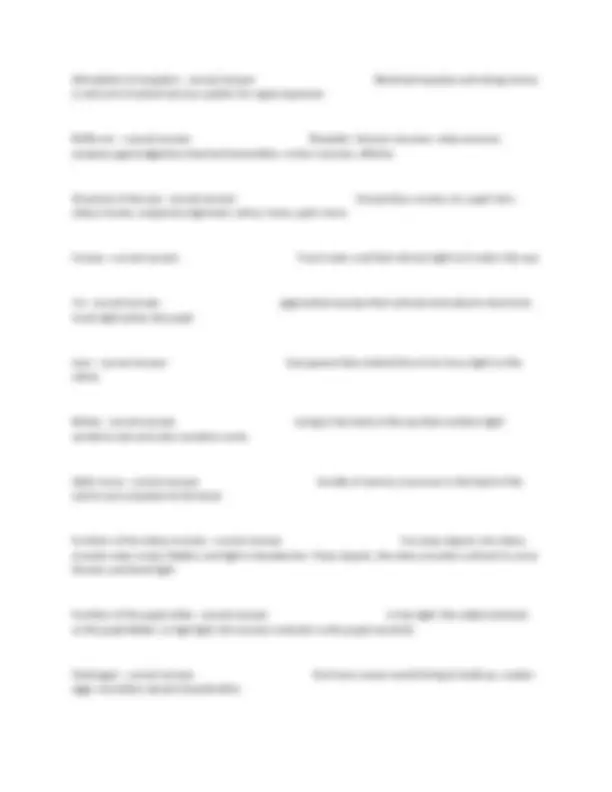
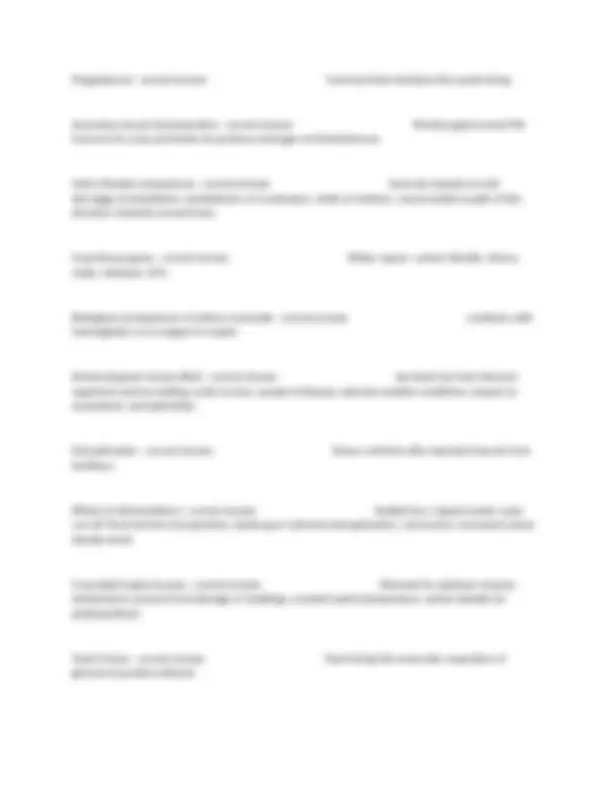
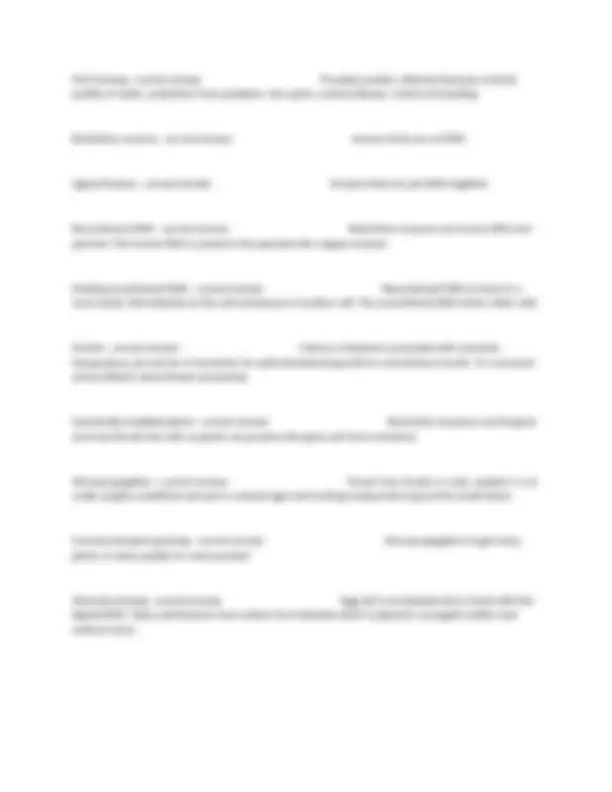


Study with the several resources on Docsity

Earn points by helping other students or get them with a premium plan


Prepare for your exams
Study with the several resources on Docsity

Earn points to download
Earn points by helping other students or get them with a premium plan
Community
Ask the community for help and clear up your study doubts
Discover the best universities in your country according to Docsity users
Free resources
Download our free guides on studying techniques, anxiety management strategies, and thesis advice from Docsity tutors
Edexcel iGCSE Biology Complete Exam Questions Correctly Answered
Typology: Exams
1 / 21

This page cannot be seen from the preview
Don't miss anything!














Processes of living organisms - correct answer Movement, reproduction, sensitivity, control, growth, respiration, excretion, nutrition Types of living organisms - correct answer Animal, Plant, Bacteria, Protoctist, Fungi, Virus Structure of Animal Cells - correct answer Cell Membrane, Cytoplasm, Nucleus Characteristics of Animals - correct answer Multicellular, feed on other organisms, carbohydrates as glycogen Example of Animals - correct answer Human or Mosquitos Invertabrates - correct answer Animals which lack a backbone. E.g. Worms Vertabrates - correct answer Animals with a backbone. E.g. Humans Structure of Plant Cells - correct answer Cellulose cell wall, Cell membrane, Cytoplasm, Chloroplasts, Sap Vacuole, Nucleus Characteristics of Plants - correct answer Multicellular, contain chloroplasts to carry out photosynthesis, cellulose cell walls, carbohydrates as starch or sucrose Example of Plants - correct answer Flowering plants: maize, herbaceous legumes: peas Structure of Fungi - correct answer Chitin cell wall, cell membrane, cytoplasm, vacuole, nucleus
Characteristics of Fungi - correct answer Multicellular or unicellular, hyphae structures, no photosynthesis, nutrition by secreting digestive enzymes on dead organisms, carbohydrates as glycogen Example of Fungi - correct answer Multicellular: Mushrooms, Unicellular: Yeast Characteristics of Protoctists - correct answer Microscopic, usually unicellular, can resemble plants or animals Example of Protoctists - correct answer Amoeba, Chlorella Structure of Bacteria - correct answer Cell wall, cell membrane, capsule, plasmids, nucleoid chromosome, sphere, rod, or spiral shape Characteristics of Bacteria - correct answer Unicellular, small organisms, circular DNA instead of nucleus, some can photosynthesis others are saprotrophic feeding Example of Bacteria - correct answer Lactobacillus bulgaricus, Pneumoccus Structure of Virus - correct answer Membrane from host cell, protein coat, DNA or RNA Characteristics of Virus - correct answer Smallest organisms, non cellular, parasitic pathogens Example of Viruses - correct answer Influenza, HIV Pathogens - correct answer Organisms which cause disease, usually fungi or bacteria
Function of Skeletal and Muscle systems - correct answer Movement, support and protection Organs in the reproductive system - correct answer Ovaries and Testes Function of reproductive system - correct answer Produce an offspring Tissues - correct answer Cells with a similar function that are grouped together Organs - correct answer A group of tissues acting together to perform a particular function Cells - correct answer Structural units of organisms Organelles - correct answer Structures inside cells like cytoplasm and cell membranes Nucleus - correct answer Largest organelle containing chromosomes which carry genetic material Cell Membrane - correct answer thin, flexible barrier around a cell; regulates what enters and leaves the cell Cytoplasm - correct answer a jellylike fluid inside the cell where the organelles are found Cell wall - correct answer Layer of freely permeable material, cellulose or chitin, outside the cell membrane that keeps the cell's shape
Chloroplasts - correct answer Absorb light energy to make food in the process of photosynthesis; green due to presence of chlorophyll Vacuole - correct answer Filled with cell sap, a store of dissolved sugars, mineral ions and other solutes. Permanent in plants Function of Nucleus - correct answer To control the activities of the cell and hold the genetic material Function of Cell membrane - correct answer Controls what enters and leaves the cell Function of Cytoplasm - correct answer Where chemical reactions take place Function of Cell Wall - correct answer Provide the cell with support and protection Function of Vacuole - correct answer Store molecules like amino acids and sugars Function of Chloroplasts - correct answer Where photosynthesis occurs Chemical elements in carbohydrates - correct answer Carbon, hydrogen, and oxygen Chemical elements in proteins - correct answer Carbon, hydrogen, oxygen, and nitrogen Chemical elements in lipids - correct answer Carbon, hydrogen, and oxygen Simple molecules of carbohydrates - correct answer Starch and glycogen made up of simple sugars
Factors that affect rate of movement of substances in and out of cells - correct answer Surface area to volume ratio, temperature and concentration gradient. How surface area to volume ratio affects rate of movement - correct answer Increase surface area with same volume increase rate of movement How temperature affects rate of movement - correct answer Temperature is average kinetic energy so a high temperature increases kinetic energy therefor increased rate How concentration gradients affects rate of movement - correct answer A high concentration gradient increases rate of diffusion into cells Photosynthesis equation - correct answer 6CO₂+6H₂O→C₆H₁₂O₆+6O₂ Photosynthesis - correct answer The process of converting light energy into chemical energy Factors affecting the rate of photosythesis - correct answer Concentration of carbon dioxide, light intensity, temperature How carbon dioxide affects the rate of photosythesis - correct answer Increasing carbon dioxide levels through hydrocarbonate solution will increase the rate until constant How light intensity affects the rate of photosythesis - correct answer More light, through a lamp or direct sunlight, increases the light energy to the chloroplast until constant How temperature affects the rate of photosynthesis - correct answer Enzymes in the process of photosynthesis work at an optimum temperature Leaf adaptations for photosynthesis - correct answer Large surface area to collect, thin for diffusion, palisade cells in upper section, chloroplasts containing chlorophyll, stomatal
pores allowed in, space in mesophyll for diffusion of CO₂ and movement of water, xylem transports water, phloem translocates sugars. Why do plants need mineral ions - correct answer For growth, magnesium ions for chlorophyll and nitrate ions for animo acids Carbohydrates in the diet - correct answer Starches and sugars for energy stores Balanced diet - correct answer correct proportions of the food groups Why do humans need food - correct answer energy to respire and matter for cells and tissues Water in the diet - correct answer needed in the semi liquid cytoplasms to allow movement of particles and allow chemical reactions to occur Fats in the diet - correct answer Long term energy stores and insulation layer Proteins in the diet - correct answer growth and repair of muscle tissues, make up hair, muscles and enzymes Fibre in the diet - correct answer Allows for peristalsis, aids digestive system and increases roughage Sources of carbohydrates - correct answer Bread, Pasta Sources of proteins - correct answer Fish, meat, leafy vegetables Sources of lipids - correct answer Dairy, nuts
Anaemia - correct answer A condition where there is a deficiency of red cells or of haemoglobin, lacking oxygen for respiration and tiredness. Ingestion - correct answer Taking food in through the mouth Digestion - correct answer Large insoluble molecules converted into small soluble molecules, by enzymes, which can be absorbed into the blood Peristalsis - correct answer Contraction of the circular muscles behind the food in the oesophagus that push the food along. Mouth in the alimentary canal - correct answer Mechanical breakdown through chewing, saliva contains amylase for mechanical breakdown and mucus to lubricate. Oesophagus in the alimentary canal - correct answer Site of peristalsis Stomach in the alimentary canal - correct answer Stores food, churned by muscular walls, introduction of acid to kill bacteria and provide pH for proteases Pancreas in alimentary canal - correct answer Secrets digestive enzymes Liver in alimentary canal - correct answer Releases bile from gull bladder to neutralise stomach acid and emulsify fat Small intestine in alimentary canal - correct answer Absorption of digested food into blood Large intestine in alimentary canal - correct answer Absorbs water into the blood stream Rectum and Anus in alimentary canal - correct answer Stores and compacts faeces then solid waste is removed by the sphincter muscles through egestion
Absorption - correct answer Villi and Micro villi absorb food from the small intestine into the blood Assimilation - correct answer Digested food in the blood diffuse into the cells Egestion - correct answer Removal of undigested material Role of digestive enzymes - correct answer The breakdown of large insoluble molecules into small soluble molecules so they can be absorbed from the small intestine into the blood Breakdown of starch - correct answer Starch→maltose→glucose by amylase and maltase Breakdown of proteins - correct answer Proteins→Amino acids by proteases Breakdowns of lipids - correct answer Lipids→Fatty acids and glycerol by lipases Bile - correct answer An alkaline fluid made in the liver, stored in the gall bladder, and released into the duodenum. Bile neutralises stomach acid and emulsify lipids Villi - correct answer Finger-like projections lining the small intestine Villus in aiding absorption - correct answer Large surface area for absorption, small diffusion distance into blood stream, high concentration gradient, lacteal collects lipid Aerobic Respiration - correct answer Respiration with oxygen Anaerobic Respiration - correct answer Respiration without oxygen
Role of phloem - correct answer Transports sucrose and amino acids as sap from the leaf in translocation to places like the growing bud Role of Xylem - correct answer Transports water and mineral salts, like nitrates and phosphates, from the roots upwards Plant water absorbtion - correct answer Root hair cells on the plant's roots weave between soil particles. The high concentration in the root hair cells creates a concentration gradient so, by osmosis, the water moves from the soil into the root and into the cortex Transpiration - correct answer evaporation of water from the surface of the plant in the stomatal pores Factors affecting rate of transpiration - correct answer Low humidity, high wind speeds, high temperature, and high light intensity create a high concentration gradient for diffusion Composition of blood - correct answer Plasma, white blood cells, red blood cells, platelets Role of plasma - correct answer transports blood cells, carbon dioxide, dissolved nutrients, urea, hormones and distributes heat around the body Adaptations of red blood cell - correct answer Biconcave disc creates short diffusion distance, no nucleus so more space for haemoglobin, no mitochondria to use oxygen in aerobic respiration, haemoglobin to carry oxygen How phagocytes respond to disease - correct answer Engulf their cytoplasm around the bacteria, enclose the bacteria in a vacuole and secret digestive enzymes How lymphocytes respond to disease - correct answer recognise the antigen and produce antibodies to stick bacteria together, label them, burst them or neutralise toxins
vaccination - correct answer Weakened or dead virus to trigger our white blood cells to produce antibodies to fight a specific pathogen so second response is sooner, faster and greater function of platelets - correct answer fragments of large cells that for a clot to prevent blood loss and entry of pathogens Structure of heart - correct answer heart rate in exercise - correct answer Most pumps per minute as the need for oxygenated blood for the respiring muscle cells increases heart rate in adrenaline - correct answer Response to fight or flight by providing oxygen for more energy in aerobic respiration Arteries - correct answer Carry blood away from the heart, large pressure from pumps so they have to give and recoil Veins - correct answer Carry blood into the heart, low pressure and valves to prevent backflow Capillaries - correct answer Carry blood through organs close to cells, small with thin walls Structure of circulation system - correct answer Blood vessels to and from the heart, lungs, liver, kidneys Plant excretion - correct answer Plants excrete carbon dioxide and oxygen as waste products of metabolism, they are lost from the stomata of the leaf Organs of excretion - correct answer Lungs, kidney, skin
High ADH - correct answer Concentrated blood increases collecting duct permeability to reabsorb water, urine is concentrated and of a small volume Low ADH - correct answer Dilute blood reduces collecting duct permeability so less water is reabsorbed, urine is dilute and of a large volume Coordination and response of organism - correct answer organisms are sensitive and can respond to changes in their environment. They can regulate their internal environment (water and temperature) through homeostasis. This requires a stimulus, receptor and effector Geotropism - correct answer Plant response to gravitational stimuli, roots have positive tropism, stems have negative tropism Phototropism - correct answer Plant response to light stimuli, stems have positive tropism Auxin - correct answer The plant hormone that controls the growth in response to light Population - correct answer Number of organisms of a species found in an area Community - correct answer A group of interacting species found in an area Habitat - correct answer When an organism lives Ecosystems - correct answer Interaction between living and non living in an area Using quadrats to estimate population size - correct answer Sample the area and count organisms inside, repeat to estimate population size
Representative quadrat sampling - correct answer In at least 10 random quadrats count the population. Find the average to find per m² Producers - correct answer organisms that can make their own food Primary consumers - correct answer Animals that feed on the producers Secondary Consumers - correct answer Animals that eat the primary consumer Tertiary Consumers - correct answer Animals that eat the secondary consumer Decomposers - correct answer organisms that break down dead or decaying organisms, and in doing so, carry out the natural process of decomposition Food chains and food webs - correct answer Pyramid of number - correct answer Pyramid of biomass - correct answer Organisms counted and weighed Pyramid of energy transfer - correct answer always loss of energy Loss of energy between trophic levels - correct answer Only 10% of energy is passed on as MRS GREN requires energy especially for respiration Stages of water cycle - correct answer Evaporation, transpiration, condensation, precipitation (surface runoff) to living thing
Stimulation of receptors - correct answer Electrical impulses sent along nerves in and out of central nervous system for rapid responses Reflex arc - correct answer Receptor, Sensory neurone, relay neurone, synapses gap bridged by chemical transmitters, motor neurone, effector Structure of the eye - correct answer Conjunctiva, cornea, iris, pupil, lens, ciliary muscle, suspensory ligament, retina, fovea, optic nerve Cornea - correct answer Front outer coat that refracts light as it enters the eye Iris - correct answer pigmented muscles that contract and relax to show how much light enters the pupil Lens - correct answer transparent discs behind the iris to focus light on the retina Retina - correct answer Lining in the back of the eye that contains light sensitive rods and color sensitive cones. Optic nerve - correct answer bundle of sensory neurones in the back of the eye to carry impulses to the brain Function of the ciliary muscles - correct answer Far away objects, the ciliary muscles relax so lens flattens and light is bended less. Close objects, the ciliary muscles contract to curve the lens and bend light Function of the pupil reflex - correct answer In low light, the radial contracts so the pupil dilates. In high light, the circular contracts so the pupil constricts Oestrogen - correct answer Hormone causes womb lining to build up, creates eggs, secondary sexual characteristics
Progesterone - correct answer hormone that maintains the womb lining Secondary sexual characterisitics - correct answer Pituitary gland sends FSH hormone to ovary and testes to produce oestrogen and testosterone Sulfur Dioxide consquences - correct answer Acid rain impacts on soft skin/eggs of amphibians, exoskeletons of crustaceans, shells of molluscs, mucus builds on gills of fish, dissolves nutrients around trees Greenhouse gases - correct answer Water vapour, carbon dioxide, nitrous oxide, methane, CFCs Biological consequences of carbon monoxide - correct answer combines with haemoglobin so no oxygen to respire Enhanced green house effect - correct answer Sea level rise from thermal expansion and ice melting, arctic ice loss, spread of disease, extreme weather conditions, impact on ecosystems, eutrophication Eutrophication - correct answer Excess nutrients after leached minerals from fertilizers Effects of deforestations - correct answer Habitat loss, impacts water cycle: run off, flood and less transpiration, leaching of nutrients/eutrophication, soil erosion, increased carbon dioxide levels Crop yield in glass houses - correct answer Warmed for optimum enzyme temperature, prevent frost damage of seedlings, constant yearly temperature, carbon dioxide for photosynthesis Yeast in beer - correct answer Yeast brings the anaerobic respiration of glucose to produce ethanol